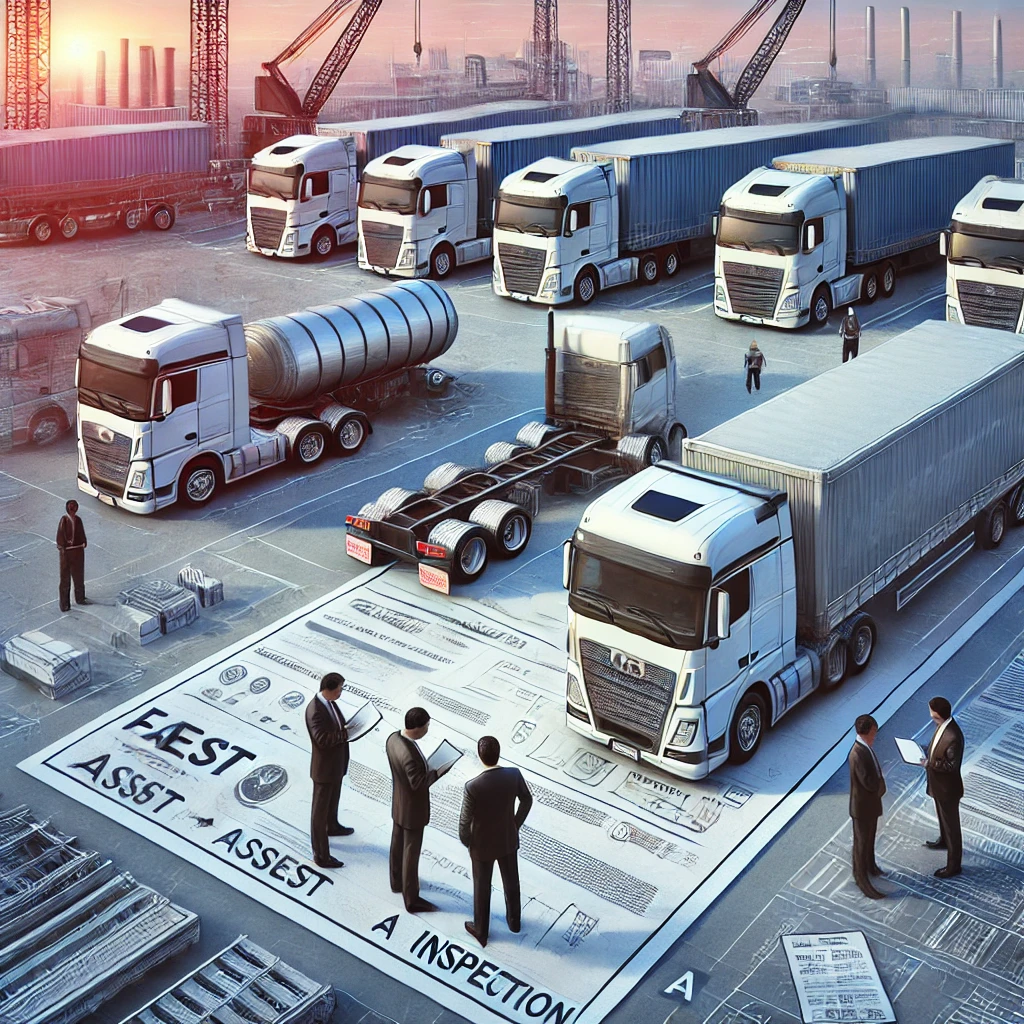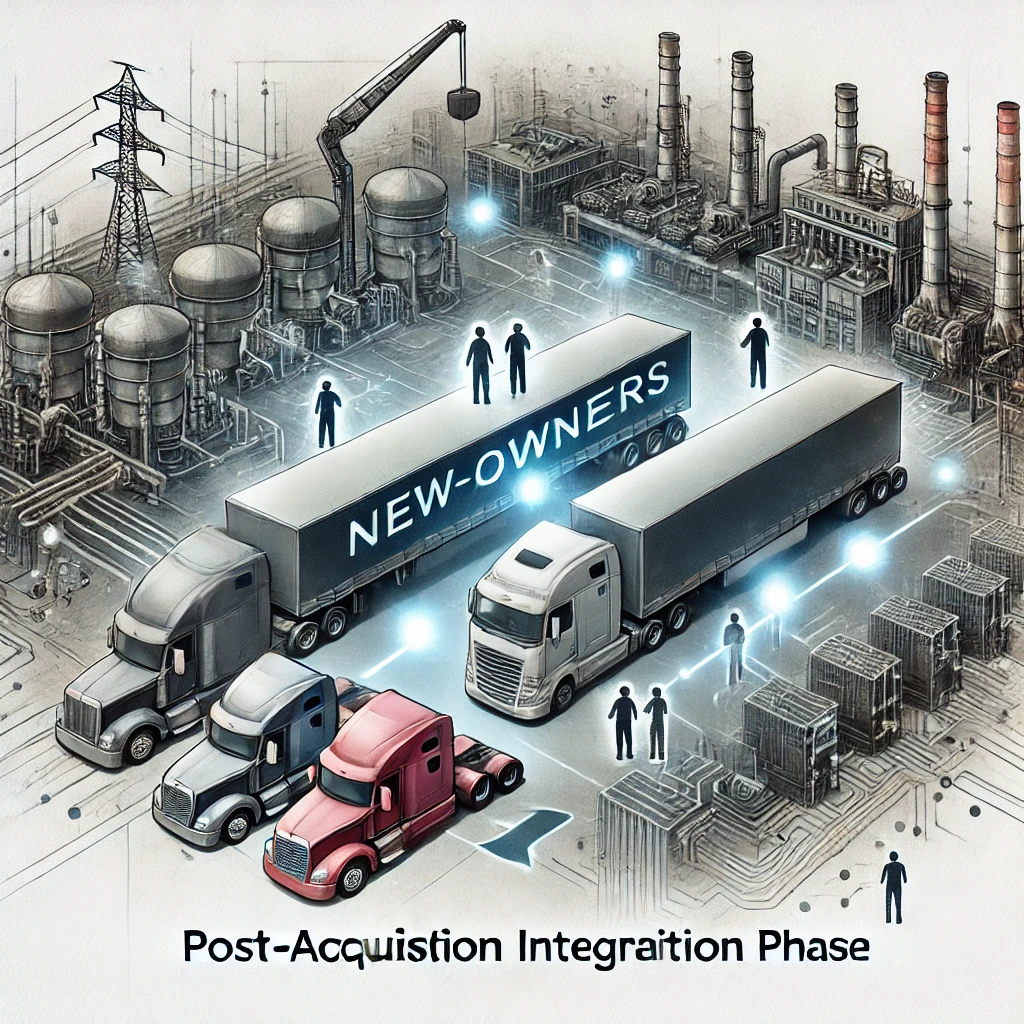The Definitive Guide to Buying a Trucking Company: From Evaluation to Integration

Table of Contents
Why Consider Buying a Trucking Company?
Before diving into the acquisition process, it’s crucial to understand the potential benefits of buying an existing trucking company:
- Instant Market Entry: Acquire an established customer base and operational infrastructure.
- Economies of Scale: Expand your existing operations or gain immediate scale in the industry.
- Diversification: Add new services or geographical coverage to your business portfolio.
- Talent Acquisition: Gain experienced drivers, dispatchers, and management staff.
- Synergies: Combine strengths of your existing business with the acquired company.
- Growth Acceleration: Achieve faster growth compared to organic expansion.
However, it’s equally important to consider potential challenges such as integration issues, hidden liabilities, and cultural differences.
Preparing for the Acquisition
Proper preparation is key to a successful acquisition. Follow these steps:
- Define Your Objectives:
- Clarify your reasons for buying a trucking company
- Set specific goals for the acquisition (e.g., revenue targets, market expansion)
- Assess Your Resources:
- Evaluate your financial capacity
- Identify key team members who will be involved in the acquisition process
- Understand the Trucking Industry:
- Research current market trends and challenges
- Familiarize yourself with industry regulations and compliance requirements
- Develop Acquisition Criteria:
- Define the ideal company profile (size, location, services offered)
- Establish deal-breakers and must-haves
- Build Your Advisory Team:
- Engage an experienced M&A attorney
- Hire a financial advisor or accountant familiar with trucking industry acquisitions
- Consider bringing on an industry consultant for specialized insights
- Create a Timeline:
- Set realistic deadlines for each stage of the acquisition process
- Allow for flexibility to address unexpected issues
Finding the Right Trucking Company to Buy
Identifying suitable acquisition targets requires a strategic approach:
- Leverage Industry Networks:
- Attend trucking industry conferences and events
- Join trucking associations and participate in their activities
- Utilize Online Resources:
- Search business-for-sale websites specializing in trucking companies
- Monitor industry publications for potential opportunities
- Engage Business Brokers:
- Work with brokers specializing in transportation industry M&A
- Provide them with your specific acquisition criteria
- Direct Outreach:
- Identify companies that match your criteria and reach out directly
- Be prepared for both positive responses and rejections
- Consider Distressed Companies:
- Look for companies facing financial difficulties that might be open to acquisition
- Assess the potential for turnaround and associated risks
- Explore Complementary Businesses:
- Consider companies in related fields (e.g., logistics, warehousing) that have trucking operations
- Use Data Analytics:
- Employ data mining techniques to identify potential targets based on financial and operational metrics
.

Conducting a Thorough Due Diligence
Once you’ve identified a potential acquisition target, comprehensive due diligence is crucial:
- Financial Analysis:
- Review at least 3-5 years of financial statements
- Analyze cash flow, profitability trends, and working capital requirements
- Scrutinize accounts receivable and payable
- Operational Assessment:
- Evaluate fleet condition and maintenance records
- Assess route efficiency and load optimization
- Review fuel management practices
- Customer Base Evaluation:
- Analyze customer concentration and contract terms
- Assess the risk of customer loss post-acquisition
- Evaluate potential for cross-selling or upselling
- Human Resources Review:
- Examine employee contracts, particularly for key personnel
- Review driver retention rates and recruitment practices
- Assess company culture and potential integration challenges
- Compliance and Legal Review:
- Verify all necessary licenses and permits
- Review safety records and DOT compliance history
- Identify any pending litigation or regulatory issues
- Technology Infrastructure:
- Assess the company’s IT systems and software
- Evaluate data security measures and cybersecurity practices
- Determine compatibility with your existing systems
- Market Position Analysis:
- Evaluate the company’s competitive advantages
- Assess market share and growth potential
- Identify potential synergies with your existing operations
- Environmental Due Diligence:
- Review environmental compliance records
- Assess potential liabilities related to fuel storage or hazardous material transport.
Valuation Techniques for Trucking Companies
Accurately valuing a trucking company involves several methods:
- Asset-Based Valuation:
- Calculate the net asset value (assets minus liabilities)
- Pay special attention to the value of the truck fleet and other equipment
- Earnings-Based Valuation:
- Use multiples of EBITDA (typically 3-5x for trucking companies)
- Consider adjusting for one-time expenses or revenues
- Discounted Cash Flow (DCF) Analysis:
- Project future cash flows and discount them to present value
- Account for industry trends and company-specific growth prospects
- Comparable Company Analysis:
- Compare valuation multiples of similar trucking companies
- Adjust for differences in size, growth, and profitability
- Rule of Thumb Methods:
- Use industry-specific metrics like revenue per truck or per mile
- These can serve as a quick sanity check but shouldn’t be the sole valuation method
- Strategic Value Assessment:
- Consider additional value from synergies or strategic positioning
- This can justify a premium over standard valuation methods
Remember, valuation is both an art and a science. The final price should reflect not just current value, but future potential and associated risks.
Structuring the Deal
How you structure the acquisition can significantly impact its success:
- Asset Purchase vs. Stock Purchase:
- Asset purchase allows you to cherry-pick assets and avoid certain liabilities
- Stock purchase is simpler but means assuming all assets and liabilities
- Payment Structure:
- All-cash deals provide clean breaks but require more upfront capital
- Seller financing can align interests but extends the relationship
- Earnouts can bridge valuation gaps but need careful structuring
- Representations and Warranties:
- Ensure comprehensive reps and warranties from the seller
- Consider rep and warranty insurance for larger deals
- Non-Compete and Non-Solicitation Agreements:
- Protect your investment by preventing the seller from competing or poaching employees/customers
- Transition Services Agreement:
- Arrange for the seller to provide temporary support post-acquisition if needed
- Employee Retention Strategies:
- Structure incentives to retain key personnel
- Consider employment agreements for crucial team members
- Regulatory Approvals:
- Factor in time and conditions for necessary regulatory approvals
- Tax Considerations:
- Structure the deal to optimize tax implications for both parties
- Consult with tax professionals to understand all ramifications

Financing Options for Buying a Trucking Company
Explore various financing options to fund your acquisition:
- Traditional Bank Loans:
- Suitable for buyers with strong credit and collateral
- May require personal guarantees
- SBA Loans:
- Government-backed loans with favorable terms
- 7(a) and 504 programs can be used for business acquisitions
- Seller Financing:
- The seller accepts payments over time
- Can demonstrate the seller’s confidence in the business
- Private Equity:
- Brings in additional expertise along with capital
- Requires giving up some control
- Asset-Based Lending:
- Uses the trucking company’s assets (like vehicles) as collateral
- Can be more accessible than traditional loans
- Mezzanine Financing:
- Bridges the gap between senior debt and equity
- Higher interest rates but less dilutive than equity
- Leveraged Buyout (LBO):
- Uses a combination of equity and significant debt
- Suitable for larger acquisitions with stable cash flows
- Crowdfunding:
- Emerging option for smaller acquisitions
- Can be combined with other financing methods
Choose a financing strategy that aligns with your risk tolerance and long-term business goals.
Navigating Legal and Regulatory Considerations
The trucking industry is heavily regulated, making legal compliance crucial:
- DOT Compliance:
- Ensure all DOT numbers and operating authorities are transferable
- Review compliance with hours-of-service regulations
- Environmental Regulations:
- Verify compliance with EPA regulations on emissions
- Check for any outstanding environmental liabilities
- Labor Laws:
- Understand implications of existing union contracts, if any
- Ensure compliance with FLSA and other labor regulations
- Insurance Requirements:
- Verify adequate coverage for all operations
- Plan for any necessary changes or additions to insurance policies
- State-Specific Regulations:
- Be aware of varying regulations in different states of operation
- Ensure all state permits and licenses are current and transferable
- Safety Regulations:
- Review safety ratings and any outstanding violations
- Assess compliance with FMCSA regulations
- Intellectual Property:
- Verify ownership and transferability of any trademarks or patents
- Ensure proper licensing for all software used in operations
- Contract Review:
- Thoroughly review all existing contracts (customers, suppliers, leases)
- Understand change-of-control provisions and their implications

Post-Acquisition Integration Strategies
Successful integration is critical for realizing the full value of your acquisition:
- Develop a Comprehensive Integration Plan:
- Set clear goals and timelines for the integration process
- Assign responsibilities to key team members
- Communication Strategy:
- Develop a clear communication plan for employees, customers, and suppliers
- Address concerns and questions promptly and transparently
- Cultural Integration:
- Assess cultural differences and plan for their reconciliation
- Foster a unified company culture that combines the best of both organizations
- Operational Integration:
- Standardize processes and systems where beneficial
- Identify and implement best practices from both companies
- Financial Integration:
- Consolidate financial reporting systems
- Implement unified budgeting and forecasting processes
- IT Systems Integration:
- Plan for the merger of IT infrastructures
- Ensure data security throughout the transition
- Human Resources Integration:
- Harmonize HR policies and benefits
- Provide necessary training for new systems or procedures
- Customer Retention Strategy:
- Reach out to key customers to ensure continuity
- Develop plans to leverage new capabilities for existing customers
- Synergy Realization:
- Identify and track synergy opportunities
- Implement processes to capture identified synergies
- Performance Monitoring:
- Establish KPIs to track integration progress
Common Pitfalls to Avoid
Be aware of these common mistakes when buying a trucking company:
- Inadequate Due Diligence: Failing to thoroughly investigate all aspects of the business.
- Overestimating Synergies: Being too optimistic about potential cost savings or revenue increases.
- Neglecting Cultural Fit: Underestimating the importance of aligning company cultures.
- Poor Communication: Failing to communicate effectively with employees and stakeholders during the transition.
- Overlooking Regulatory Issues: Not fully understanding or addressing compliance requirements.
- Underestimating Integration Challenges: Failing to plan adequately for the complexities of merging operations.
- Losing Key Employees: Not taking steps to retain crucial staff members.
- Ignoring Customer Relationships: Failing to manage customer expectations and relationships during the transition.
- Inadequate Financing: Not securing sufficient capital to fund both the acquisition and post-acquisition needs.
- Neglecting Day-to-Day Operations: Focusing too much on the deal and not enough on running the business.

Future-Proofing Your Acquisition
Consider these factors to ensure long-term success:
- Technology Adoption:
- Invest in emerging technologies like AI for route optimization and IoT for fleet management
- Consider the potential impact of autonomous vehicles on the industry
- Sustainability Initiatives:
- Explore eco-friendly practices and technologies
- Prepare for increasing environmental regulations
- Diversification:
- Look for opportunities to expand into related services
- Consider vertical integration strategies
- Talent Development:
- Implement programs to attract and retain skilled drivers and technicians
- Invest in training and development for all employees
- Adaptable Business Model:
- Build flexibility into your operations to adapt to market changes
- Develop contingency plans for various economic scenarios
- Customer-Centric Approach:
- Invest in improving customer experience through technology and service innovations
- Develop long-term strategic partnerships with key clients
- Data Analytics Capabilities:
- Build strong data analysis capabilities to inform decision-making
- Use predictive analytics to anticipate market trends and operational needs
How Linbis Logistics Software Can Optimize Your New Trucking Business
The trucking industry is heavily regulated, making legal compliance crucial:
- DOT Compliance:
- Ensure all DOT numbers and operating authorities are transferable
- Review compliance with hours-of-service regulations
- Environmental Regulations:
- Verify compliance with EPA regulations on emissions
- Check for any outstanding environmental liabilities
- Labor Laws:
- Understand implications of existing union contracts, if any
- Ensure compliance with FLSA and other labor regulations
- Insurance Requirements:
- Verify adequate coverage for all operations
- Plan for any necessary changes or additions to insurance policies
- State-Specific Regulations:
- Be aware of varying regulations in different states of operation
- Ensure all state permits and licenses are current and transferable
- Safety Regulations:
- Review safety ratings and any outstanding violations
- Assess compliance with FMCSA regulations
- Intellectual Property:
- Verify ownership and transferability of any trademarks or patents
- Ensure proper licensing for all software used in operations
- Contract Review:
- Thoroughly review all existing contracts (customers, suppliers, leases)
- Understand change-of-control provisions and their implications

Post-Acquisition Integration Strategies
Successful integration is critical for realizing the full value of your acquisition:
- Develop a Comprehensive Integration Plan:
- Set clear goals and timelines for the integration process
- Assign responsibilities to key team members
- Communication Strategy:
- Develop a clear communication plan for employees, customers, and suppliers
- Address concerns and questions promptly and transparently
- Cultural Integration:
- Assess cultural differences and plan for their reconciliation
- Foster a unified company culture that combines the best of both organizations
- Operational Integration:
- Standardize processes and systems where beneficial
- Identify and implement best practices from both companies
- Financial Integration:
- Consolidate financial reporting systems
- Implement unified budgeting and forecasting processes
- IT Systems Integration:
- Plan for the merger of IT infrastructures
- Ensure data security throughout the transition
- Human Resources Integration:
- Harmonize HR policies and benefits
- Provide necessary training for new systems or procedures
- Customer Retention Strategy:
- Reach out to key customers to ensure continuity
- Develop plans to leverage new capabilities for existing customers
- Synergy Realization:
- Identify and track synergy opportunities
- Implement processes to capture identified synergies
- Performance Monitoring:
- Establish KPIs to track integration progress

Conclusion
Buying a trucking company is a complex process that requires careful planning, thorough due diligence, and strategic execution. By following the steps outlined in this comprehensive guide, you can navigate the challenges of acquisition and set yourself up for success in the trucking industry.
Remember these key takeaways:
- Clear Objectives: Start with a clear understanding of why you’re making the acquisition and what you hope to achieve.
- Thorough Due Diligence: Leave no stone unturned when investigating the target company. The more you know, the better prepared you’ll be.
- Fair Valuation: Use multiple valuation methods to arrive at a fair price that reflects both current value and future potential.
- Proper Deal Structuring: Structure the deal in a way that aligns with your goals and mitigates risks.
- Adequate Financing: Ensure you have sufficient capital not just for the purchase, but for post-acquisition integration and operations.
- Regulatory Compliance: Stay on top of the complex regulatory environment in the trucking industry.
- Effective Integration: Plan for and execute a thorough integration process to realize the full value of your acquisition.
- Future-Proofing: Consider long-term trends and invest in technologies like Linbis Logistics software to stay competitive.
- People Focus: Remember that beyond the trucks and routes, you’re acquiring a team. Prioritize clear communication and cultural integration.
- Continuous Improvement: Use data and analytics to continuously optimize your operations and adapt to market changes.
By keeping these principles in mind and leveraging advanced tools like Linbis Logistics software, you can turn your trucking company acquisition into a springboard for growth and success in this vital industry. Whether you’re expanding an existing operation or entering the trucking business for the first time, a well-executed acquisition can be a transformative step towards achieving your business goals.
